
|   |

|   |
Adi Ashtakam: Odissi's artistic alchemy with Ashtakams - Satish Suri e-mail: satishism@yahoo.co.in Photos: Prof.K.S.Krishnamurthy August 25, 2023 The journey from abstract philosophy to tangible performing art stands as a remarkable testament to human creativity. Usha RK through her profound dedication, breathed life into the verses of Adi Shankaracharya's Ashtakams, transforming them into a dance form intricately woven with musical essence deserving of fullest admiration. The very creation of music for this endeavour emerged as a formidable challenge, as the musicians grappled with the task of intertwining ragas and diverse musical patterns to harmonise with the performance demands. The choreography, a symphony of movements, was a collaborative manifestation of the artistes' prowess guided by the wisdom of their respective gurus. Standing as the guiding light through this intricate process was Usha RK, her meticulous shepherding ensuring the unbroken continuity and seamless flow of the narrative. In the Odissi format, six individual artists took to the stage, each portraying a distinct Ashtakam meticulously chosen for the evening. But before the dance unfurled, Usha RK's elucidation of the Ashtakams' inner meanings bestowed clarity on the composition, connecting the audience to the depth of the verses. Sahana Maiya: Sharada Bhujanga Ashtakam 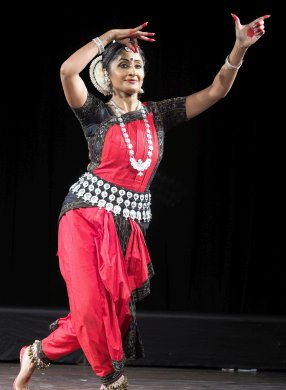 Sahana Maiya On August 2, a tale of devotion unfolded through the elegant artistry of Odissi. The evening commenced with Sahana Maiya, who, with her graceful presence, took on the embodiment of Sharada Bhujanga Ashtakam in "Bhaje Sharadamba". With each gesture and stance, Sahana Maiya painted a portrait of Sharadamba, her physical features and ethereal beauty brought to life. The portrayal beyond the ordinary, transcending into the realm of the mythical was the one who rode upon the deer, horse, and even the lion evoking a sense of regality and untamed spirit. The imagery didn't stop there - even an intoxicated elephant became a vessel of her grace, a symbol of power harmonised with an aura of intoxicating allure. As the dance unfolded, the Ashtakam's verses narrated more than physical attributes. They spoke of a cosmic creator, the architect of the nine forms of creation, an entity of immeasurable depth and boundless potential. The divine entity was further depicted as a serene force, perpetually tranquil amid the ebb and flow of existence. Sahana Maiya's movements became the brushstrokes of this narrative, her dance narrating the story not just through motion but through the very spirit that radiated from her being. The devotional fervour embedded within the verses was enlivened with finesse and found expression in its most genuine and heartfelt form. Rasika Gumasthe: Yamuna Ashtakam 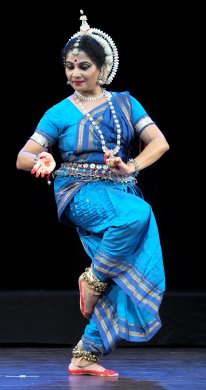 Rasika Gumasthe In the timeless cascade of Shankaracharya's compositions, the Yamuna Ashtakam emerges as a sparkling gem, a lyrical ode to the rivers that cradle the soul of India. This particular verse, among the many jewels crafted by the philosopher, dances in reverence to the Yamuna, its pure waters embodying a spiritual cleansing of the mortal coil. Within its lines, the Yamuna Ashtakam paints a portrait of the river's sanctifying touch. The water becomes a conduit for redemption, flowing as a benevolent current that sweeps away the weight of sins. The imagery unfurls like the pages of an ancient scripture. Moonbeams of autumn adorn the Yamuna, casting a luminous embrace upon its pristine surface. This celestial adornment paints the river with an aura of serenity and celestial connection as if the very heavens have bestowed grace upon its waters. The narrative weaves in the river's rich history. The Yamuna becomes the canvas upon which sages and celestial beings etch their stories. Sage Narada himself bathes in its rejuvenating stream, and the Gopis, those ethereal dancers of love and devotion, find solace in its embrace. The Kalinga mountain too, once imprisoned by its arrogance, whose liberation was intertwined with Lord Krishna's divine play. As Krishna conquered the serpent, the river celebrated its liberation cascading freely, a poignant remainder of the cyclical nature of grace and freedom. The river's course takes a poetic twist as it secretly embraces the essence of Radha and Krishna. The sacred dance of love becomes an eternal undercurrent, a clandestine symphony that only the heart attuned to its essence can perceive. In this rendition, Rasika Gumaste from Pune took the reins, a masterful conduit for the Ashtakam's essence. With each note and intonation, she breathed life into the verses, her movements echoing the river's meandering path, her expressions the ripples of its waters allowing them to resonate in the hearts of the audience. Nuance by nuance, she captured the river's journey from a mere water body to a living entity with its own stories. She unravelled the mystique behind Sage Narada's choice, making his plunge into Yamuna's waters and in her movements, she's transformed into the Gopis, carrying their devotion in every step. But perhaps the pinnacle of her artistry lay in her portrayal of Yamuna's intimate connection with Krishna and Radha. Through her, the river's depths whispered of love, a love that wasn't loud but quiet, and profoundly personal. With a glance, a gesture she evoked the sacred touch of Radha and Krishna, a connection known only to them and yet shared with the world through her movements. In the realm of artistic rendition, Rasika Gumaste emerges as the torchbearer of this hymn's profound beauty, evoking the sanctity of the river's touch on the divine dance of love and liberation that it carries within its waters. Madhur Gupta: Jagannath Ashtakam 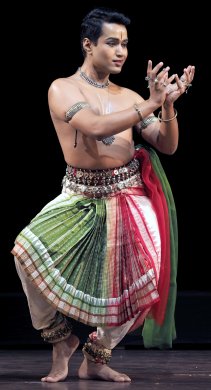 Madhur Gupta Jagannath Ashtakam is a verse that paints a portrait of the divine in exquisite detail. As this verse unfurls, it is as if the Lord of the flute himself steps forth, his radiance echoing through the syllables. The verse becomes a canvas upon which the Lord's glory is depicted stroke by stroke. His eyes, pools of enchantment, mirror the cosmos, reflecting a wisdom that spans eternity. His face, unblemished and serene, speaks of purity beyond measure. Each feature is described not in isolation but as a part of a symphony of divine aesthetics. The focal point remains his lotus feet, a symbol of the paths he walks. There are imprints of compassion upon the earth, a testimony of his enduring presence among us. The portrayal transcends the physical, encompassing his cosmic realm. He rests upon the coils of Adisesha, the cosmic serpent, an image of his omnipresence. The oceans of his mercy seem to lap against the shores as he stretches beyond horizons to embrace all. And as the verse "Jai Jagannatha Swami Nayana Patha Gami" reaches its crescendo, it shifts to the ethereal. The Lord becomes a witness to creation's dance. He stands unshaken amid the tides of destruction, a silent observer of cycles beyond comprehension. But in this observance lies his grace. He liberates, emancipates and unchains. His mere presence unlocks the shackles of existence allowing souls to soar free. Within the intricate tapestry of Madhur Gupta's performance, the essence of the verse found its full expression. Each dimension of the Ashtakam was meticulously woven, creating a seamless fabric where devotion, movement, and expression converged in a profound impact of devotion and skill united in harmony. As the dance reached its zenith, the verse's essence seemed to transcend its literary origins, blooming into a living testimony of human capability and unshaken will of devotion. Namrata Mehta: Ganga Ashtakam 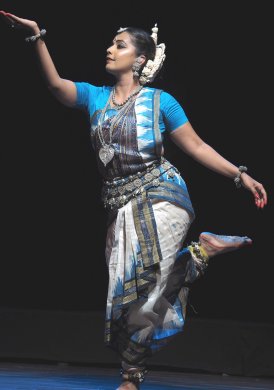 Namrata Mehta Within the verses of Ganga Ashtakam, the essence of the sacred river flows, carrying with it the reverence of ages. The verses unveil Ganga as more than just the river; she is the embodiment of power and purity. Like a mother, she bestows her blessings upon all, a benefactor whose presence exudes auspiciousness. Within her currents lies the very essence of life and death, the eternal dance of existence. She is the Supreme Goddess herself, an earthly representation of cosmic divinity. The narrative takes us back to Bhagiratha's devotion, his unwavering pursuit to bring the celestial river to Earth. In the cascade of Ganga's descent, we witness the merging of the divine with the mortal, as she graces the terrestrial realm. In the tresses of Lord Shiva, Ganga finds a tranquil abode. A single drop from her sacred waters has the power to cleanse the soul of all transgressions, an act of divine purification. She crowns Shiva's head like an ornamental gem, a symbol of her consecration to the divine trinity. And then she becomes Janavi, the mother of souls, the culmination of a spiritual journey. "Let my devotion to Shiva and Vishnu be permanent," the verse implores, sealing the bond between human and divine. The Ganga with all her cosmic and earthly dimensions seemed to manifest through Namrata Mehta's graceful form. The power and purity of the river formed their expression in every step, each movement a homage to the embodiment of the sacred that the Ganga symbolised. As she moved through the verses, her expressions transformed into a mirror to the emotions encapsulated in the words. She became the mother, the benefactor, and the embodiment of auspiciousness, her performance not just reflecting these qualities but radiating them. Even the subtlest nuances weren't lost in her portrayal. Every step seemed to echo the journey of Bhagirata, the resolve to bring the divine to Earth, the struggle, and the ultimate triumph. The enchantment of Lord Shiva and the divine charm of his tresses came alive in her movements. With each sway, she caught the sanctity that even the divine finds in Ganga's touch. As the final note "O Gange"` resonated, it was as if the Ganga Ashtakam found its true voice, not in words but in Namrata Mehta's artistry. Kala Bhairava Ashtakam: Sourav Mohanty 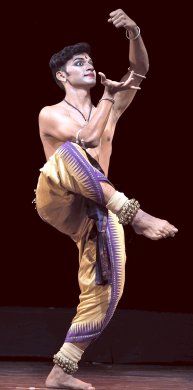 Sourav Mohanty In sacred Kashi, Kala Bhairava stands as the supreme Lord, an enigmatic figure of both awe and reverence. With easy description, the verses paint a picture of a deity who transcends conventional forms embodying the essence of paradox and power. His sacred thread is a serpent, a symbol of his dominion over life cycles. The blue throat, a result of his divine act, reflects his role in the cosmic dance. His three eyes, not just a physical phenomenon but a mystical representation of his cosmic vision, pierce through illusions to reveal the truth. The lotus-like eyes mirror purity, an oasis of beauty in the mix of his fierce presence. Kala Bhairava is more than just a deity; he is the master of righteousness, the one who bestows liberation. His garland of skulls is a depiction of his dominion over mortality in a reminder of the ephemeral nature of existence. Golden hued snakes coiled around his form, and adornment marries beauty with the eerie, creating a paradoxical visual that terror is his multifaceted nature. But beyond the symbols, Kala Bhairava dances with an abandon that transcends earthly norms. His dance isn't just a rhythmic movement; it's a manifestation of divine madness, a cosmic whirl that resonates with the pulse of the universe. In Sourav Mohanty's rendition, Kala Bhairava burst forth with vibrant life, embodying the very essence described in the verses. His performance was an immersive exploration of the deity's multifaceted nature and his dance of wild abandon. With every movement, Sourav Mohanty channelled Kala Bhairava's dynamic presence. The dance became an invocation, a means through which the deity's essence was summoned to the stage. His embodiment of the deity mirrored the intricate blend of power and grace, beauty and ferocity. His movements exuded raw energy, a kind of liberated ecstasy that mirrored the deity's dance described in the verses. The final note reverberated like the deity's laughter, leaving a tangible energy in the air. In those moments, the physicality of the dance dissolved into the metaphysical, a living testament to the power of expression and devotion through movement. Guru Ashtakam: Madhulita Mohapatra 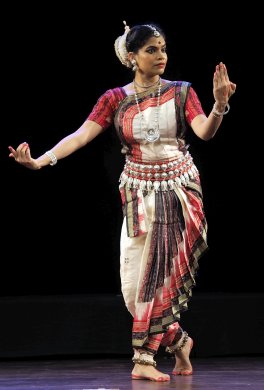 Madhulita Mohapatra In the profound verses of Guru Ashtakam, the essence of devotion is woven into the very fabric of existence. He speaks not of material wealth or external accomplishments, but of the centrality of the Guru in one's spiritual journey. The verses remind us that regardless of the treasures one amasses, whether it's wealth, a beautiful abode, or a flourishing family these external riches are secondary when the mind isn't centred at the Guru's feet. "Tatah Kim Tatah Kim" echoes as a reminder that without this spiritual anchor, even the grandest of achievements are ultimately devoid of true meaning. The verses offer a contrasting image: that of residing in a forest, a symbol of solitude and simplicity. However, they emphasise that even in such an environment, when the mind isn't centred at the Guru's feet, it lacks the true essence of devotion and connection. Madhulita Mohapatra's depiction of Guru Ashtakam was a creative, unique interpretation that illuminated the verses from a fresh perspective. Through her artistry, she blended the nuances of Odissi's dance with the emotional depth of the verses, resulting in a fusion that was both visually captivating and spiritually moving. With precision and grace, her creativity elevated the verses to new heights, offering a profound testament to the enduring power of artistic expression and devotion. The intricate footwork, expressive hand gestures, and emotive expressions wove together to create a deeply evocative portrayal. The live music ensemble, under the guidance of Basistha Kumar Nayak on vocals, Soubhagya Narayan on the mardala, Pradeep Moharana on the violin, and Rudra Parida on the flute, added a distinctive layer to the artistes' presentations. The vocal rendition by Basistha Kumar Nayak became the heartbeat of the performance. His voice resonated with depth and emotion. Soubhaghya Naraayan's mastery of the mardala infused rhythmic vitality. Pradeep Moharana's violin added a touch of elegance and emotional resonance. Rudra Parida's flute added a celestial touch. The airy notes of the flute seemed to weave through the air, evoking a sense of transcendence and serenity. 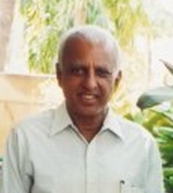 Bangalore based Satish Suri is an avid dance rasika besides being a life member of the Music and Arts Society. |